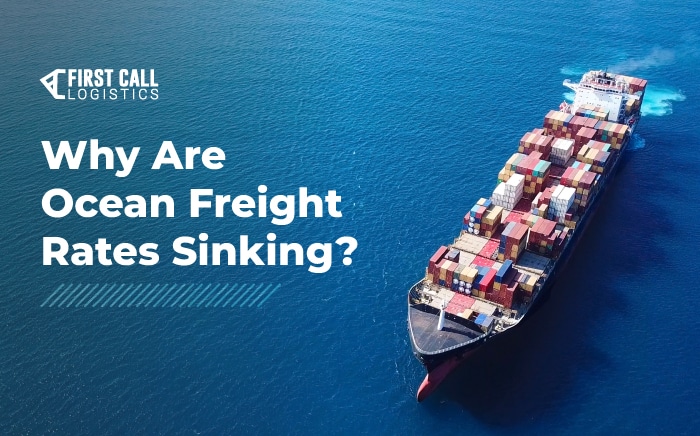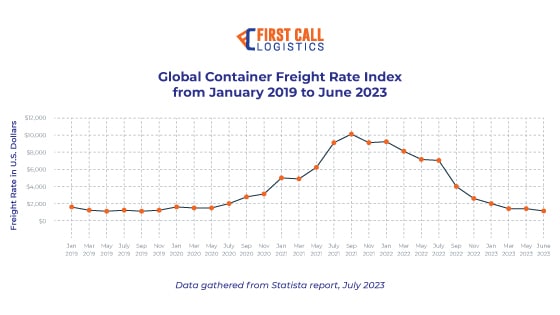Why Are Ocean Freight Rates Sinking?

Ocean freight is the cornerstone of world trade, with about 80% of goods being transported overseas. Its far-reaching influence on the world’s supply chains makes it both an essential component of our global economy and a strong predictor of that economy’s trajectory.
Maritime shipping’s critical role in trade globalization garnered a particular focus throughout the pandemic, as COVID-19’s effects drove container freight rates to historic highs while ports around the world suffered worker shortages, public health restrictions and near-impassable supply chain bottlenecks.
Global Container Shipping Rates 2023 | Statisa. (2023)
The resulting shortages pushed the rate of a single 40-foot container from around $1,500 in 2019 to nearly $10,400 by the end of 2021. Economists and shipping lines have always understood this dramatic surge wasn’t sustainable, and might have even plunged the world’s economies into further turmoil — however, as today’s container costs level out, the U.S. has (so far) managed to stave off a proper recession.
That’s good news for consumer demand, which by all accounts appears to be on the rise. But for the ocean carriers moving the vast majority of the world’s goods, a severe dip in rates has created an intriguing paradox: why aren’t rates improving alongside demand?
The Bond Between Freight and Inventory
The leading theory is bloated inventories.
During the pandemic, elevated demand enticed companies to order goods at higher volume. Many of those orders wound up sitting in understaffed ports waiting to be unloaded as the pandemic measures slowly lifted. Once supply chains normalized, that excess inventory was finally delivered and stored. Today, companies find themselves dealing with inflated inventories and no immediate need to order more — thus, the demand for container freight plummets.
Most industry experts agree this misalignment between consumer and container demand is only temporary, but no one knows exactly how long it will take for these companies to deplete their inventories enough to realign with their customers (for some, it looks like things are already business as usual). Some reports show consumer spending confidence as the healthiest it’s been since 2021 — but it could always reverse course if the threat of recession returns.
As for the carriers, though the recent boom allowed many to pay down debts and build significant cash reserves, net income dropped at an alarming rate through much of the summer — and only now are companies inching themselves out of months in the red (barely).
Ongoing Problems with Port Congestion
Though circumstances have improved greatly since the peak pandemic years, port congestion continues to cause significant logistical headaches.
The causes of port congestion are varied, but many stem from circumstances brought on by the COVID-19 pandemic; most workforces were trimmed down and have yet to return to normal levels, resulting in lost efficiency during loading and unloading processes. Some ports had more containers coming in than going out and now have piles of empty containers taking up space in their terminals. Other ports are experiencing a massive shortage of shipping containers (because so many containers are stranded in ports around the globe).
All of these contribute to port congestion, reduce port productivity and increase logistics costs throughout the supply chain. These costs are inevitably passed down to businesses and their customers, reflected in the steadily rising cost of everyday items despite the drop in container rates.
A Greener Future for Container Shipping
Recent challenges within the ocean freight industry are concerning, but the future outlook isn’t all bad. In fact, there are some exciting developments on the horizon — a major shift in consumer priorities towards sustainability has the industry placing greater emphasis on reducing carbon emissions and adopting eco-friendly shipping practices. In fact, many governments have likewise instituted various initiatives to reduce the environmental impact of ocean freight.
When it comes to crossing large bodies of water, ocean freight is more environmentally friendly than its airborne counterpart. Even so, one container ship emits about 140 million metric tons of carbon dioxide per year, and bulk carriers emit around 440 million metric tons annually (for the sake of comparison, a flatbed truck emits about 223 tons of carbon per year).
Many shipping companies are also investing in low-carbon fuels as alternatives to gasoline and emissions-reducing technology like scrubbers that remove harmful elements from ship exhaust before it’s released into ocean waters. There are even several engineering developments on the horizon for the actual building and design of new ships, including the possibility of fully electric cargo ships.
Together, technological advancements and sustainability initiatives are making it possible for container shipping to have a greener future. Considering the number of supply chains depending on container ships to move their goods, we’d call that a win.
Simplify your Next Shipment with First Call Logistics
More Resources for FCL Shippers:
Get the latest supply chain news and updates directly to your inbox.

